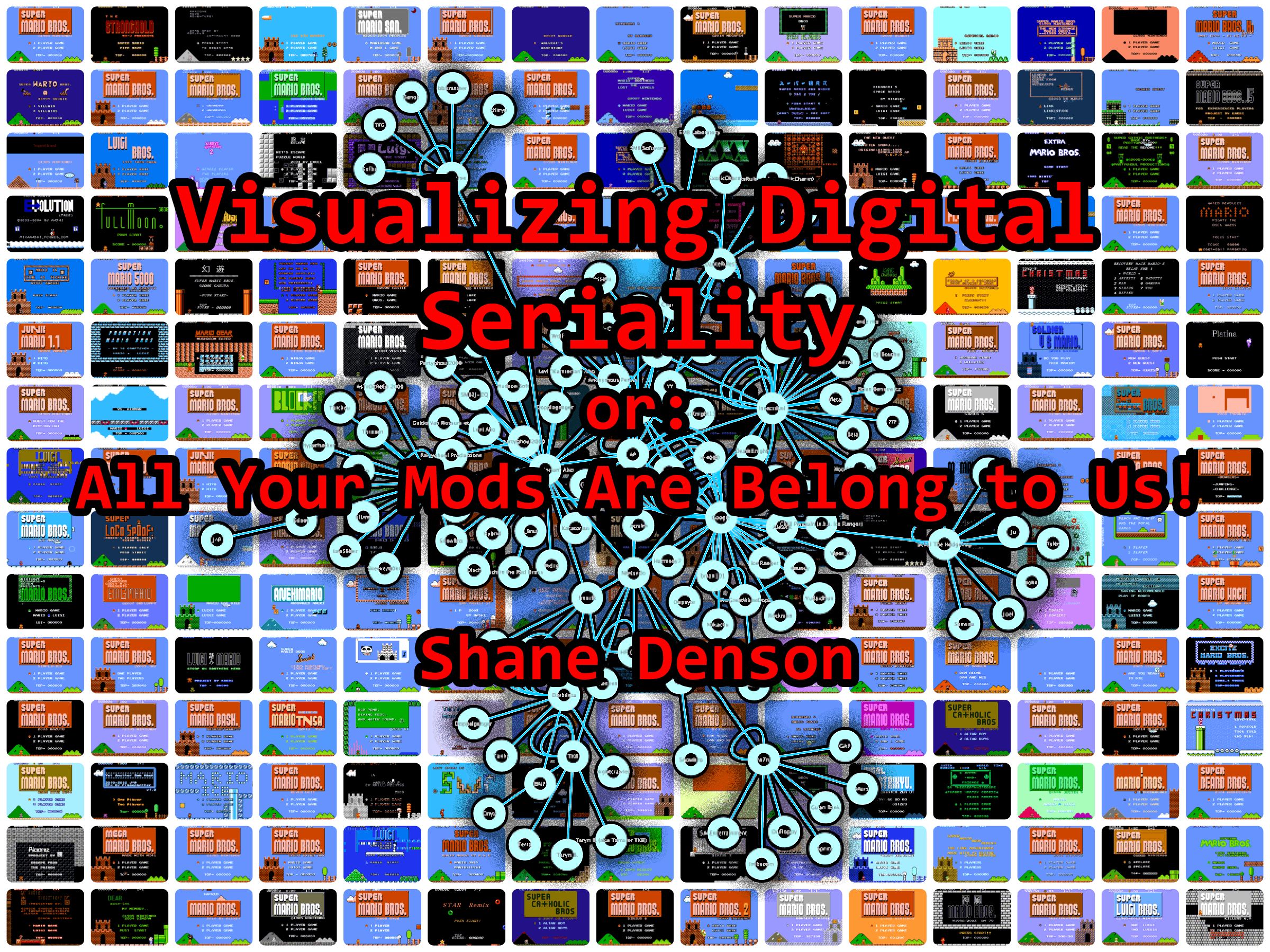
References
- Allen, Rob, & van den Berg, Thijs (Eds.). (2014). Serialization in popular culture. New York, NY: Routledge.
- Anderson, Benedict. (1991). Imagined communities: Reflections on the origin and spread of nationalism (2nd ed.) London, England: Verso.
- Anderson, Benedict. (1998). The spectre of comparisons: Nationalism, Southeast Asia and the world. London, England: Verso.
- Beil, Benjamin, Engell, Lorenz, Schröter, Jens, Schwaab, Herbert, & Wentz, Daniela (Eds.). (2012). Die Serie. Special issue of Zeitschrift für Medienwissenschaft, 7(2).
- Boluk, Stephanie, & LeMieux, Patrick. (2012). Hundred thousand billion fingers: Seriality and critical game practices. Leonardo Electronic Almanac, 17(2), 14–35. Retrieved October 27, 2015, from http://www.leoalmanac.org/wp-content/uploads/2012/04/LEAVol17No2-BolukLemieux.pdf
- Davis, Andréa, Webb, Suzanne, Lackey, Dundee, & DeVoss, Dànielle Nicole. (2010). Remix, play, and remediation: Undertheorized composing practice. In Heather Urbanski (Ed.), Writing and the digital generation: Essays on new media rhetoric (pp. 186–197). Jefferson, NC: McFarland.
- Denson, Shane. (2011). »To be continued…«: Seriality and serialization in interdisciplinary perspective. Journal of Literary Theory Online. Retrieved October 27, 2015, from http://www.jltonline.de/index.php/conferences/article/view/346/1004
- Denson, Shane, & Jahn-Sudmann, Andreas. (2013). Digital seriality: On the serial aesthetics and practice of digital games. Eludamos: Journal for Computer Game Culture, 7(1), 1–32. Retrieved October 27, 2015, from http://www.eludamos.org/index.php/eludamos/article/view/vol7no1-1
- Denson, Shane, & Jahn-Sudmann, Andreas (Eds.). (2014). Digital seriality. Special issue of Eludamos: Journal for Computer Game Culture, 8(1). Retrieved October 27, 2015, from http://www.eludamos.org/index.php/eludamos/issue/view/vol8no1
- Denson, Shane, & Mayer, Ruth. (2012). Grenzgänger: Serielle Figuren im Medienwechsel. In Kelleter, Frank (Ed.), Populäre Serialität: Narration — Evolution — Distinktion. Zum seriellen Erzählen seit dem 19. Jahrhundert (pp. 185–203). Bielefeld, Germany: Transcript-Verlag.
- Eco, Umberto. (1985). Innovation and repetition: Between modern and post-modern aesthetics. Daedalus, 114(4), 161–184.
- Gries, Laurie. (2015). Still life with rhetoric: A new materialist approach for visual rhetorics. Boulder, CO: University Press of Colorado.
- Gries, Laurie. (2017). Mapping Obama hope: A data visualization project for visual rhetorics. Kairos: A Journal of Rhetoric, Technology, and Pedagogy, 21(2). Retrieved March 6, 2017, from http://kairos.technorhetoric.net/21.2/topoi/gries/index.html
- Hagedorn, Roger. (1988). Technology and economic exploitation: The serial as a form of narrative presentation. Wide Angle, 10(4), 4–12.
- Jenkins, Henry. (2006). Convergence culture: Where old and new media collide. New York, NY: New York University Press.
- Kelleter, Frank (Ed.). (2012). Populäre Serialität: Narration — Evolution — Distinktion. Zum seriellen Erzählen seit dem 19. Jahrhundert. Bielefeld, Germany: Transcript-Verlag.
- Manovich, Lev. (2001). The language of new media. Cambridge, MA: MIT Press.
- Marino, Mark. (2006, December 4). Critical code studies. Electronic Book Review. Retrieved October 27, 2015, from http://www.electronicbookreview.com/thread/electropoetics/codology
- Mayer, Ruth. (2013). Serial Fu Manchu: Iconocity, ideology, and the logic of global spread. Philadelphia, PA: Temple University Press.
- McNely, Brian. (2015). Instagram, geocaching, and the when of rhetorical literacies. Kairos: A Journal of Rhetoric, Technology, and Pedagogy, 19(3). Retrieved April 21, 2017, from http://kairos.technorhetoric.net/19.3/topoi/mcnely/index.html
- Mittell, Jason. (2006). Narrative complexity in contemporary American television. The Velvet Light Trap, 58(1), 29–40.
- Moretti, Franco. (2005). Graphs, maps, trees: Abstract models for a literary theory. London, England: Verso.
- Moretti, Franco. (2013). Distant reading. London, England: Verso.
- Potts, Liza. (2014). Social media in disaster response: How experience architects can build for participation. New York, NY: Routledge.
- Potts, Liza. (2015). Can't stop the fandom: Writing participation in the Firefly 'verse. Kairos: A Journal of Rhetoric, Technology, and Pedagogy, 19(3). Retrieved April 21, 2017, from http://kairos.technorhetoric.net/19.3/topoi/potts/index.html
- Prior, Paul, Solberg, Janine, Berry, Patrick, Bellwoar, Hannah, Chewning, Bill, Lunsford, Karen J., Rohan, Liz, Roozen, Kevin, Sheridan-Rabideau, Mary P., Shipka, Jody, Van Ittersum, Derek, & Walker, Joyce R. (2007). Resituating and re-mediating the canons: A cultural-historical remapping of rhetorical activity. Kairos: A Journal of Rhetoric, Technology, and Pedagogy, 11(3). Retrieved April 1, 2017, from http://kairos.technorhetoric.net/11.3/binder.html?topoi/prior-et-al/index.html
- Ridolfo, Jim, & DeVoss, Dànielle Nicole. (2009). Composing for recomposition: Rhetorical velocity and delivery. Kairos: A Journal of Rhetoric, Technology, and Pedagogy, 13(2). Retrieved April 21, 2017, from http://kairos.technorhetoric.net/13.2/topoi/ridolfo_devoss/
- Russell, David R. (2009). Uses of activity theory in written communication research. In Annalisa Sannino, Harry Daniels, & Kris D. Gutiérrez (Eds.), Learning and expanding with activity theory (pp. 40–52). Cambridge, MA: Cambridge University Press.
- Sartre, Jean-Paul. (1991 [1960]). Critique of dialectical reason, volume 1: Theory of practical ensembles. London, England: Verso.
- Spinuzzi, Clay. (2010). Secret sauce and snake oil: Writing monthly reports in a highly contingent environment. Written Communication 27(4), 363–486.
- Stedman, Kyle. (2012). Remix literacy and fan compositions. Computers and Composition, 29(2), 107–123.